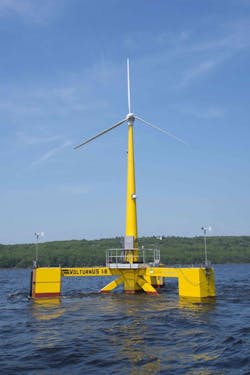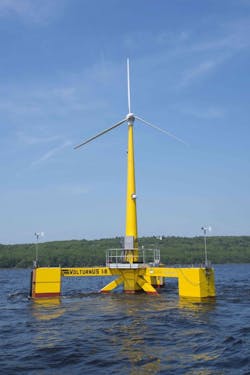With new technology, plans piling up on drawing boards, and mounting debates on how they’re built, wind energy projects may be emerging as one of the most dynamic renewable energy sectors.
Recent developments in the state of Maine, as one example, have all those features. For one, the state is emerging as a leader in the development of floating wind turbine technology tailored to deep-water projects. Secondly, it’s poised to attract strong interest from developers because its location is ideally suited to wind energy production. Thirdly, activists are pushing hard to give organized labor an inside track on electrical and the many other jobs any build-out would create.
The state’s energy office recently unveiled a Maine Offshore Wind Roadmap. A document 18 months in the making it charts a course for making the unusually deep, windy waters off the state an integral part of the nation’s future wind energy grid. In laying out a strategy, it references the Biden administration’s announcement last September noting the expected role of floating offshore wind platforms. To meet its goal of having 30 GW of offshore wind projects deployed by 2030, the administration says more floating platforms will be needed. It’s aiming for 15 GW of floating-turbine energy by 2035.
Maine’s plan calls for positioning the Gulf of Maine to first host a test bed for floating turbine technology. Technology being developed at the University of Maine could have an inside track (see Photo). The school’s Advanced Structures & Composites Center has a patented VolturnUS floating concrete hull configuration that can support wind turbines in waters up to 45 meters in depth. The federal Bureau of Ocean Energy Management is considering an application to locate a research array of 10 to 12 VolturnUS turbines in the waters off Maine’s coast.
Announcing the roadmap’s release, the governor’s office said the state is well-positioned to be an important contributor to the nation’s wind energy future. With highly favorable off-shore wind patterns, and even before much has been done to site any turbines, the state is home to some 80 companies working on some element of offshore wind power, the release noted.
Ahead of the roadmap’s release, a Maine state senator introduced a bill that attempts to establish a formal process for creation of a wind energy industry in the state. Introduced by Mark Lawrence, the bill calls for the competitive procurement of 2.8 GW of floating offshore wind over the next 12 years, a process the state’s public utilities commission would oversee.
Backed by state labor and environmental groups, the bill is drafted partly to ensure projects unfold “responsibly.” “This bill will make sure we’re acting on the timeline necessary to avoid the worst impacts of climate change while ensuring strong standards for environment, labor, and equity,” Lawrence said at a press release announcing the bill in late January.
On the labor question, the bill reportedly makes a strong case for requiring union labor and/or union-friendly project labor or labor peace agreements on projects. The bill makes a much stronger push for that then the roadmap, setting the stage for legislative tension to arise as the bill is debated and the roadmap turned into policy.
Jason Shedlock, president of the Maine State Building & Construction Trades Council and regional organizer with the Laborers’ International Union, was quoted in an Energy News Network story on the bill as saying a union requirement would help ensure more Maine citizens benefit from wind power development by keeping out-of-state, non-union companies out.
The debate over the constitution of labor on the prospective projects mirrors that taking place on other wind projects around the country. Developers of projects in other states, such as New Jersey, have instituted union-friendly policies after intensive lobbying by unions for making organized labor utilization a central focus. A Bloomberg Law story last July detailed those efforts.
The intensity of debate, positioning, planning, and research swirling around the Maine effort, only one of many nationwide, seems to attest to the growing importance of wind power in the renewable energy revolution. Indeed, the stakes aren’t small: to meet the Biden administration goal of 30 GW of offshore wind power by 2030, 2,100 wind turbines, 6,800 miles of cable, $8 billion in port investments, and up to 49,000 full-time-equivalent workers will be needed. How that all gets done, and by whom, are the questions of the moment.
Tom Zind is an independent analyst and freelance writer based in Lees Summit, Mo. He can be reached at [email protected].
About the Author
Tom Zind
Freelance Writer
Zind is a freelance writer based in Lee’s Summit, Mo. He can be reached at [email protected].

